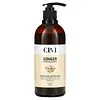What's inside
What's inside
 Key Ingredients
Key Ingredients

 Benefits
Benefits

 Concerns
Concerns

 Ingredients Side-by-side
Ingredients Side-by-side

Water
Skin ConditioningDisodium Laureth Sulfosuccinate
CleansingSodium C14-16 Olefin Sulfonate
CleansingCocamidopropyl Betaine
CleansingSodium Chloride
MaskingHydrogenated Poly(C6-14 Olefin)
EmollientPolysorbate 20
EmulsifyingZingiber Officinale Root Oil
MaskingZingiber Officinale Root Extract
MaskingHoney Extract
HumectantPropolis Extract
Skin ConditioningRoyal Jelly Extract
Skin ConditioningArgania Spinosa Kernel Oil
EmollientOlea Europaea Fruit Oil
MaskingSimmondsia Chinensis Seed Oil
EmollientPolyquaternium-10
Piroctone Olamine
PreservativeMethylpropanediol
SolventLaurylpyridinium Chloride
AntimicrobialAllantoin
Skin ConditioningCaramel
Cosmetic ColorantDisodium EDTA
Parfum
MaskingWater, Disodium Laureth Sulfosuccinate, Sodium C14-16 Olefin Sulfonate, Cocamidopropyl Betaine, Sodium Chloride, Hydrogenated Poly(C6-14 Olefin), Polysorbate 20, Zingiber Officinale Root Oil, Zingiber Officinale Root Extract, Honey Extract, Propolis Extract, Royal Jelly Extract, Argania Spinosa Kernel Oil, Olea Europaea Fruit Oil, Simmondsia Chinensis Seed Oil, Polyquaternium-10, Piroctone Olamine, Methylpropanediol, Laurylpyridinium Chloride, Allantoin, Caramel, Disodium EDTA, Parfum
Water
Skin ConditioningSodium Lauryl Sulfate
CleansingMipa-Laureth Sulfate
CleansingCocamidopropyl Betaine
CleansingSodium Chloride
MaskingGlycerin
HumectantPEG-18 Castor Oil Dioleate
EmulsifyingPropylene Glycol
HumectantCeteareth-60 Myristyl Glycol
EmulsifyingPEG-55 Propylene Glycol Oleate
Persea Gratissima Oil
Skin ConditioningLaureth-5 Carboxylic Acid
CleansingPPG-5-Ceteth-20
EmulsifyingSodium Benzoate
MaskingSodium Hydroxide
BufferingCitric Acid
BufferingLaureth-2
CleansingPolyquaternium-53
Salicylic Acid
MaskingThermus Thermophillus Ferment
Skin ConditioningButylene Glycol
HumectantLimonene
PerfumingAlcohol
AntimicrobialCitronellol
PerfumingIsopropanolamine
BufferingLinalool
PerfumingSafflower Glucoside
Phenoxyethanol
PreservativeGentiana Lutea Root Extract
Skin ConditioningTocopherol
AntioxidantCitrus Junos Fruit Extract
Skin ConditioningHelianthus Annuus Seed Oil
EmollientPotassium Sorbate
PreservativeRosmarinus Officinalis Leaf Extract
AntimicrobialSodium Citrate
BufferingParfum
MaskingWater, Sodium Lauryl Sulfate, Mipa-Laureth Sulfate, Cocamidopropyl Betaine, Sodium Chloride, Glycerin, PEG-18 Castor Oil Dioleate, Propylene Glycol, Ceteareth-60 Myristyl Glycol, PEG-55 Propylene Glycol Oleate, Persea Gratissima Oil, Laureth-5 Carboxylic Acid, PPG-5-Ceteth-20, Sodium Benzoate, Sodium Hydroxide, Citric Acid, Laureth-2, Polyquaternium-53, Salicylic Acid, Thermus Thermophillus Ferment, Butylene Glycol, Limonene, Alcohol, Citronellol, Isopropanolamine, Linalool, Safflower Glucoside, Phenoxyethanol, Gentiana Lutea Root Extract, Tocopherol, Citrus Junos Fruit Extract, Helianthus Annuus Seed Oil, Potassium Sorbate, Rosmarinus Officinalis Leaf Extract, Sodium Citrate, Parfum
Ingredients Explained
These ingredients are found in both products.
Ingredients higher up in an ingredient list are typically present in a larger amount.
Cocamidopropyl Betaine is a fatty acid created by mixing similar compounds in coconut oil and dimethylaminopropylamine, a compound with two amino groups.
This ingredient is a surfactant and cleanser. It helps gather the dirt, pollutants, and other impurities in your skin to be washed away. It also helps thicken a product and make the texture more creamy.
Being created from coconut oil means Cocamidopropyl Betaine is hydrating for the skin.
While Cocamidopropyl Betaine was believed to be an allergen, a study from 2012 disproved this. It found two compounds in unpure Cocamidopropyl Betaine to be the irritants: aminoamide and 3-dimethylaminopropylamine. High-grade and pure Cocamidopropyl Betaine did not induce allergic reactions during this study.
Learn more about Cocamidopropyl BetaineParfum is a catch-all term for an ingredient or more that is used to give a scent to products.
Also called "fragrance", this ingredient can be a blend of hundreds of chemicals or plant oils. This means every product with "fragrance" or "parfum" in the ingredients list is a different mixture.
For instance, Habanolide is a proprietary trade name for a specific aroma chemical. When used as a fragrance ingredient in cosmetics, most aroma chemicals fall under the broad labeling category of “FRAGRANCE” or “PARFUM” according to EU and US regulations.
The term 'parfum' or 'fragrance' is not regulated in many countries. In many cases, it is up to the brand to define this term.
For instance, many brands choose to label themselves as "fragrance-free" because they are not using synthetic fragrances. However, their products may still contain ingredients such as essential oils that are considered a fragrance by INCI standards.
One example is Calendula flower extract. Calendula is an essential oil that still imparts a scent or 'fragrance'.
Depending on the blend, the ingredients in the mixture can cause allergies and sensitivities on the skin. Some ingredients that are known EU allergens include linalool and citronellol.
Parfum can also be used to mask or cover an unpleasant scent.
The bottom line is: not all fragrances/parfum/ingredients are created equally. If you are worried about fragrances, we recommend taking a closer look at an ingredient. And of course, we always recommend speaking with a professional.
Learn more about ParfumChances are, you eat sodium chloride every day. Sodium Chloride is also known as table salt.
This ingredient has many purposes in skincare: thickener, emulsifier, and exfoliator.
You'll most likely find this ingredient in cleansers where it is used to create a gel-like texture. As an emulsifier, it also prevents ingredients from separating.
There is much debate on whether this ingredient is comedogenic. The short answer - comedogenic ratings don't tell the whole story. Learn more about comegodenic ratings here.
The concensus about this ingredient causing acne seems to be divided. Research is needed to understand if this ingredient does cause acne.
Scrubs may use salt as the primary exfoliating ingredient.
Learn more about Sodium ChlorideWater. It's the most common cosmetic ingredient of all. You'll usually see it at the top of ingredient lists, meaning that it makes up the largest part of the product.
So why is it so popular? Water most often acts as a solvent - this means that it helps dissolve other ingredients into the formulation.
You'll also recognize water as that liquid we all need to stay alive. If you see this, drink a glass of water. Stay hydrated!
Learn more about Water